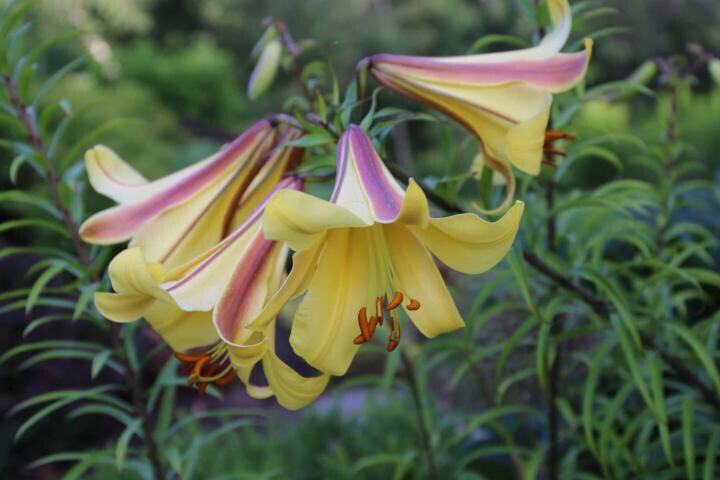During active growth, water freely—especially if rainfall is less than 1 inch per week.
Keep lilies mulched so that their roots are cool. The mulch should feel moist, but not wet. Read more about mulching.
Apply a high-potassium liquid fertilizer every 2 weeks from planting until 6 weeks after flowering.
Apply a thin layer of compost each spring, followed by a 2-inch layer of mulch.
Stake tall lilies.
Lilies do not bloom more than once per season, but you can remove the faded flowers so that the plants don’t waste energy making seeds.
After the lily blooms, you can also remove just the stem itself. However, do NOT remove leaves until they have died down and turned brown in fall. It’s very important not to cut back the leaves until the end of their season because hey help provide nourishment to the bulb for next season’s blooms.
Cut down the dead stalks in the late fall or early spring.
Before winter, add 4 to 6 inches of mulch, simply to delay the ground freeze and allow the roots to keep growing. Leave the mulch until spring once the last hard frost has passed. See your local frost dates. See your local frost dates.
If your region doesn’t have snow cover, keep soil moist in winter.
When lily shoots grow through the mulch in the spring, start to remove it gradually.
Divide plants every 3 to 4 years as new growth begins in the spring. Just lift the plants and divide the clumps. Replant the new bulbs adding some compost.

PESTS/DISEASES
Gray mold is sometimes a problem, especially in a wet, cool spring or summer. Make sure lilies are not crowded and have plenty of air circulation.
Viruses, spread by aphids, may be troublesome, although some cultivars are virus-tolerant.
Red lily beetles, slugs, and snails may occur.
Deer, rabbits, voles, and groundhogs may eat entire plants. If these critters are a problem, plant the bulbs in buried wire cages to protect them from getting eaten.
HARVEST/STORAGE
DISPLAYING LILIES IN VASES
Lilies make wonderful cut flowers. However, avoid cutting off more than a third of the stem. Taking more than that can reduce the plant’s vigor and longevity, since the plant needs its foliage to create energy.
If you are growing lilies strictly for cut flowers, consider planting them in a designated cutting garden, where you can plant fresh bulbs each year.
When cutting lilies, choose those with buds that are just about to open, with a bit of the flower color showing. The higher up buds will open as the bottom ones fade.
Just one lily stem in a vase can be a show-stopper.
As soon as you get lilies inside, trim the stem ends an inch or so, making a diagonal cut with a sharp knife.
If you worry that the orange pollen of lilies might cause stains, simply snip off the stamens in the flower’s center.
Before arranging in a vase, remove the lower leaves on the stems so that no foliage will be underwater.
A good lily arrangement will last two or more weeks. Change the water every few days.
To help prolong the flowers’ life, add cut-flower food to the water. Lilies require only half the amount of food recommended for other flowers.
Learn how to keep cut flowers fresh.
RECOMMENDED VARIETIES
There are many types of lilies which bloom at different times. With some careful planning, you can enjoy lilies all summer long by planting bulbs from different varieties.
Asiatic lilies are the earliest to bloom and the easiest to grow. With their upward facing flowers, they bloom early to midsummer. Hardy in Zones 4 to 9, Asiatic lilies come in pure white, pink, vivid yellow, orange, and red. Intense breeding has erased much of the Asiatics’ fragrance, but in spite of their lack of perfume, they are a favorite with floral arrangers.
‘Crete’: deep pink, blooms June to July, 3 to 4 feet tall
‘Enchantment’: orange, blooms in June, 2 to 3 feet tall
Trumpet lilies bloom mid-summer. Tall with trumpet-shaped flowers, they are hardy in Zones 5 to 9. Trumpet lilies grow many blooms (12 to 15 per stalk!) and have a wonderfully heady, sweet fragrance.
‘Regale’: white, blooms early to late summer, 3 to 4 feet tall
‘Rising Moon’: pastel yellow with a pink edges, blooms in mid-summer, 3 to 4 feet tall

Oriental hybrids end the season, blooming in mid- to late summer, just when Asiatic lilies are beginning to fade. From tiny 2-footers to towering 8-foot-tall giants, Orientals are always a striking choice (the shorter ones are great for patio beds or container gardens). Adored for their intoxicating fragrance that intensifies after dark, Oriental lilies produce masses of huge white, pink, red, or bi-color blooms. They make wonderful cut flowers that will fill even the largest of rooms with their spicy scents.
‘Black Beauty’: dark red, blooms in late summer, 5 to 6 feet tall
‘Casa Blanca’: white, blooms August to September, 4 to 5 feet tall
WIT & WISDOM
The name “lily” can be misleading because lots of other plants use it besides true lilies. Daylilies and water lilies aren’t lilies at all, and neither are lilies-of-the-valley or lilyturf. With so many other plants using the name “lily,” it seems that identity theft has been around since long before the use of computers and credit cards!
Easter lilies can be planted in the ground in the spring. They may survive several years if you mulch them heavily in the fall, especially in northern regions. If they survive, they’ll bloom in late summer.
In a flower bed, lilies prosper in the presence of low-growing plants that protect the lilies’ roots from drying out.